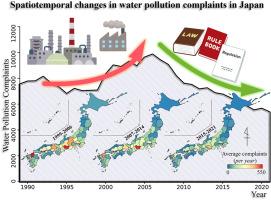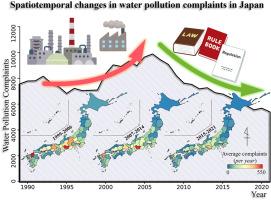Public complaints of water pollution: A long-term spatiotemporal analysis in Japan
IF 9.7
1区 环境科学与生态学
Q1 ENGINEERING, ENVIRONMENTAL
引用次数: 0
Abstract
Public complaints about water pollution are important indicators of public environmental risk perception and provide crucial feedback for evaluating the effectiveness of water resource management strategies. This study conducts a comprehensive analysis of water pollution complaints in Japan from 1989 to 2021, utilizing integrated datasets that include river networks, water quality monitoring stations, regional industrial demographics, and socioeconomic indicators. Our findings reveal a significant decline in complaints—over 45% from the peak in 2006—following the implementation of various environmental policies aimed at reducing industrial discharge and restoring natural ecosystem function. The shift in complaint targets from industries to individuals suggests that these policies have been effective in mitigating industrial pollution, while also highlighting the need to address individual behaviors that impact water quality. Despite long-term improvement in water quality indicators such as Suspended Solids (SS) and Dissolved Oxygen (DO), no significant correlation was observed between these indicators and the temporal or spatial patterns of water pollution complaints. Instead, a strong positive correlation was observed between complaints and reported water quality incidents, reflecting heightened public sensitivity to acute pollution events. Spatial analysis further identified a significant association between complaints and the manufacturing workforce, indicating that industrial activity continues to shape public perception of water pollution risks. Our findings underscore the complex interaction between public perception, environmental policies, and industrial activities, and suggest that effective water management requires a multifaceted approach. Policymakers should continue to enforce stringent industrial regulations, while also enhancing public education and communication strategies to improve awareness of individual responsibilities in water protection. This research provides a theoretical basis for developing more responsive and effective environmental policies and public education strategies.


公众对水污染的投诉:日本的长期时空分析
公众对水污染的投诉是反映公众环境风险认知的重要指标,也是评估水资源管理策略有效性的重要反馈。本研究利用河流网络、水质监测站、地区工业人口统计和社会经济指标等综合数据集,对 1989 年至 2021 年日本的水污染投诉进行了全面分析。我们的研究结果表明,随着旨在减少工业排放和恢复自然生态系统功能的各种环境政策的实施,投诉量大幅下降,从 2006 年的峰值下降了 45% 以上。投诉对象从工业转向个人,表明这些政策在减轻工业污染方面取得了成效,同时也凸显了解决影响水质的个人行为的必要性。尽管悬浮固体 (SS) 和溶解氧 (DO) 等水质指标得到了长期改善,但在这些指标与水污染投诉的时间或空间模式之间并没有发现明显的相关性。相反,在投诉和报告的水质事件之间却发现了很强的正相关性,这反映出公众对急性污染事件的敏感度有所提高。空间分析进一步确定了投诉与制造业劳动力之间的重要关联,表明工业活动继续影响着公众对水污染风险的看法。我们的研究结果强调了公众认知、环境政策和工业活动之间复杂的相互作用,并表明有效的水资源管理需要多方面的方法。政策制定者应继续执行严格的工业法规,同时加强公众教育和沟通策略,提高个人对水资源保护责任的认识。这项研究为制定反应更迅速、更有效的环境政策和公众教育战略提供了理论依据。
本文章由计算机程序翻译,如有差异,请以英文原文为准。
求助全文
约1分钟内获得全文
求助全文
来源期刊

Journal of Cleaner Production
环境科学-工程:环境
CiteScore
20.40
自引率
9.00%
发文量
4720
审稿时长
111 days
期刊介绍:
The Journal of Cleaner Production is an international, transdisciplinary journal that addresses and discusses theoretical and practical Cleaner Production, Environmental, and Sustainability issues. It aims to help societies become more sustainable by focusing on the concept of 'Cleaner Production', which aims at preventing waste production and increasing efficiencies in energy, water, resources, and human capital use. The journal serves as a platform for corporations, governments, education institutions, regions, and societies to engage in discussions and research related to Cleaner Production, environmental, and sustainability practices.
 求助内容:
求助内容: 应助结果提醒方式:
应助结果提醒方式:


